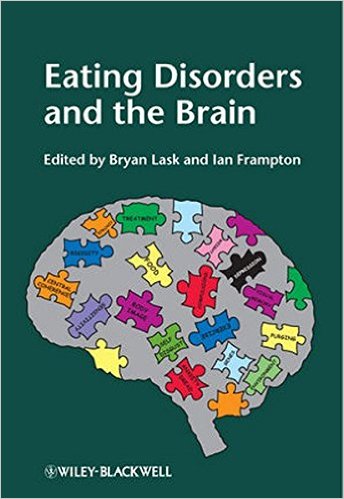
Reprinted from Eating Disorders Review
November/December 2011 Volume 22, Number 6
©2011 Gürze Books
Eating Disorders and the BrainAuthors: Bryan Lask and Ian Frampton |
Bryan Lask, an eminent British professor of child and adolescent psychiatry, and his colleague Ian Frampton, a distinguished neuropsychologist, are to be commended for pulling together this timely, erudite, and occasionally provocative volume. The international contributors they’ve engaged in this effort elegantly summarize what we currently know about structural and functional aspects of the brain and related genetic, neurochemical, and neuropsychological processes associated with eating disorders. Then, they offer tantalizing glimpses of how everything ties together.
For decades, perhaps more commonly in recent years, eating disorders experts have pondered whether eating disorders are “brain diseases”; the extent to which eating disorders reflect choices based on ‘free will’; the extent to which eating disorder symptoms may be epiphenomenal to underlying brain processes; the extent which abnormal brain processes in eating disorders stem from genetic and early developmental processes and/or result from the more acute stressors imposed upon them by patients’ acute nutritional and behavioral abnormalities; how all the bio-psycho-social-developmental systems levels presumed to contribute to the etiology and pathogenesis of eating disorders inter-relate; implications of these understandings for treatment; and related concerns.
While these thoughtful authors can’t definitively answer all of these questions, they grapple earnestly with the issues. Well written and well edited, nicely balanced between academic reviews and integrative theoretical syntheses, the readable chapters will inform readers who lack deep knowledge about biological aspects of eating disorders as well as those who are better informed. Chapters are scholarly without being stuffy, and contributors summarize pertinent studies in structural and functional neuroimaging, neuropsychology, and the neuroscience of body image.
Two chapters that I found particularly stimulating bear mention. The first is a broad-ranging, sometimes speculative, inquiry and discussion of “Why clinicians should love neuroscience: the clinical relevance of contemporary knowledge.” Here David Wood contemplates far-ranging issues, starting with mind-body dualism, free will and determinism; and vertical etiological dimensions from genes and neurotransmitters through trauma and attachment, including implications of neuroscience for psychoanalytic observations, and implications of psychoanalytic observations for neuroscience research. He also addresses spatial “horizontal” etiologic systems dimensions encompassing neuroscience and individual psychology through families, social systems, and cultural concerns.
The second, perhaps lynchpin, chapter of the book, by Kenneth Nunn, Bryan Lask, and Ian Frampton, considers, contrasts, and compares recent conceptual models bridging neuroscience and clinical eating disorders research. Included are a neurodevelopmental model for anorexia nervosa proposed by Connan et al.; a model translating experimental neuroscience into clinical practice proposed by Southgate et al; a habit-learning, cognitive neuroscience hypothesis for anorexia nervosa proposed by Steinglass and Walsh; a neuroscience model focusing on the role of the insula by Nunn et al; models involving functional disturbances in frontostriatal circuits proposed by Marsh et al; insights into symptoms and neurocircuits for anorexia nervosa proposed by Kaye et al; and a multifaceted integrative neuroscience model for anorexia nervosa proposed by Hatch et al. The models are then compared along frameworks for investigation corresponding to the recently promulgated NIMH Research Domain Criteria.
A novel chapter discusses implications for patients and families of understanding neurobiological models (more accurate attributions resulting in less stigma, shame and blame, for example), including changes in the patient’s self-representations. Beyond these are questions concerning the commercialization of biomarkers (beware the scams) and issues concerning participation in genetic and neuroscience research. Treatment implications include educating patients and their families about brain biology and eating disorders, and an excellent review and update on cognitive remediation therapy. Frampton and Lask cap the book with an uplifting and visionary summary and push toward the aforementioned NIMH Research Domain Criteria. We’re looking forward to “connectomics.”
Anything here that’s new to you? I certainly found lots new to me. For serious eating disorders clinicians as well as academicians, there’s much in this book to study and ponder.
— JY

